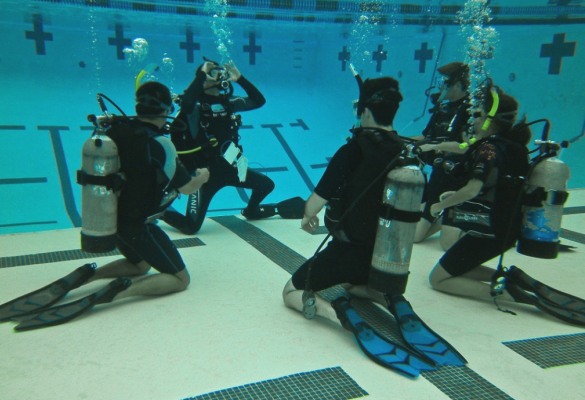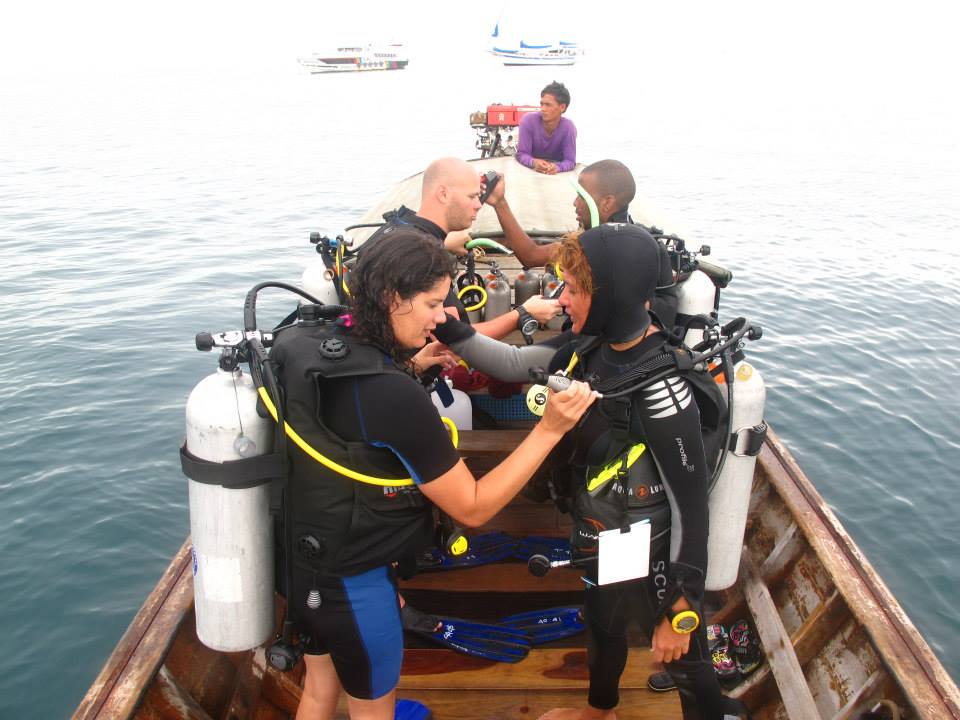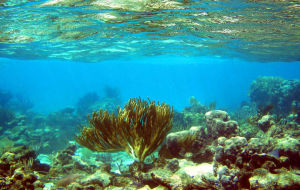
Howdy again, Greg here from Scuba happy 😆 Cold Water Diving season is upon us, so it is time to go through our diving gear and make sure your gear is for colder temperatures, wetsuit, gloves, boots and hood are the main ones to keep in mind, there is nothing more uncomfortable than getting cold during a dive.
Cold Water Diving
Tips for Diving Colder Water
I know much of what I am going to cover you already know, but we will still cover it for those who might not know about it.
Cold water robs the body’s heat 32 times faster than cold air. The biggest myth in wetsuits is that the water between the wetsuit and your skin is what keeps you warm. The only way that would be true is if the water is above your body temperature and you didn’t have to warm it from your own body. It takes one Calorie (kilo-calorie) to raise the temperature of 1 kilogram of water 1 degree Celsius. With this in mind there are three things that are the key to keeping warm as long as you can when you dive in cold water with a wetsuit. First is start off warm (your heat bank), the second is to prime with warm water (your body will use less of its heat bank warming the water) and the third is to reduce heat loss (this is insulation). Your body is a chemical engine that produces heat, but it is nowhere near up to the task to combat 33 degree F water on its own, so we need to give it a hand to give us a comfortable dive as long as we can.

You can probably guess what my first answer is going to be.  I don’t like cold hands either so I did upgrade to the three finger gloves a few months ago. My hands still get cold in them but not anything like a five finger gloves.
I don’t like cold hands either so I did upgrade to the three finger gloves a few months ago. My hands still get cold in them but not anything like a five finger gloves.
There are a few items to help you have warmer hands. First thing is start off warm. Keep gloves on while you prep and when you change into your wetsuit gloves make sure you do it in a warm area. Don’t let that cold wind get to your hands. We will get changed in a heated ice shanty which is awesome! Whatever wetsuit gloves you use keep them on while you gear up. It may take some practice and a good way to do that is to wear them at home and do your house chores for an afternoon. Once you get used to it you will be amazed what you can do with your gloves on.
I have a box of latex gloves and I will put those on my hands under my gloves. It keeps the water from coming directly in contact from my skin. If for some reason my wetsuit gloves do come off (my bad if they do) I don’t get that evaporation directly on my skin.

In cold water diving we prime our wetsuit with as warm of water as we can stand (not burning hot but really warm). I have two 2-gallon jugs one is red and the other is orange. The really warm water goes in the orange and very hot (too hot water) goes in the red jug. I have a little flip-top cooler where I also will pour very warm water in. I will put my boots, hood and gloves in this cooler to steep in that warm water. That gets the neoprene saturated with warm water. I also have a small un-insulated 2-liter Tupperware jug that I will fill with very warm water. I chose this because the two larger jugs (the red & orange one) and the Tupperware jug fit nicely in a wheeled cooler. It makes it easier for getting all the water to the dive site and it really keeps everything warm.
You said you want to stay with 5 finger gloves so I would recommend layering with the latex gloves and going with the thickest neoprene gloves you can find and still move your fingers. There are 7mm out there in a 5 finger. Watch the seams and if you gloves are getting old make sure you keep the seams sealed. This is a bad place to get any water movement. Here is something that sounds simple but if you are pulling gloves on an off while you are getting ready that you can overlook. Make sure you overlap your wetsuit with your gloves. If you have straps on your gloves make sure to tighten them down to keep water movement to a minimum.
Now something I wanted to try but I am torn between being warm and cheap. You can get some semi-dry dry gloves. I have tried these on in the dive store but not used them in the water.

I really like my three finger gloves. I can operate all my gear in them and they are much warmer than my 5mm 5 finger gloves were. If you get them a little large you can pull your pointer finger out of its solo spot and turn them into mittens during your dive and reduce your heat loss. I haven’t tried regular mittens but those will be warmer yet. I am not comfortable enough with the loss of dexterity to get some, but I would try them with some more experience and if I was doing more than one ice dive in a day.
Other than gloves the best wetsuit upgrade for keeping warm was better boots. I was using 3mm (yes 3mm) boots for my ice dive. Any sub-30 degrees F water was starting to freeze my feet in the first 10 minutes. I upgraded to some high sided boots and that made a world of difference. I zip them up and then roll my wetsuit over the outside. Surprisingly it made my fingers warmer too.
For my wetsuit I wear a 7mm AquaLung. Make sure the wetsuit is tight fitting. If it is loose anywhere that allows in cold water. The biggest myth in wetsuits is that the water between the wetsuit and your skin is what keeps you warm. For cold water diving I will wear polyester long johns and socks under it. I think it makes a difference, but I have had arguments with others who say it can’t help. Now prime, prime, prime and then prime again. Like I said before I steep my glove, hood and boots in warm water. As I am setting up I will pour some of that very hot water in my boots. When I get out of the shanty with my wetsuit on I will slip my feet into the primed wetsuit boots, but now that water cooled to bareable and is a good start. In the colder weather I will prime with my wetsuit all the way on. My warm water jug has a spout and I will start pouring down the front of my suit at the neck (between the suit and my skin). I will pour slowly and I will stop when I start to see water leaking out the seam between my boots and my suit. You can feel the warm water and you want the warm water everywhere. Then with the help of your dive buddy have them pour plenty of warm water down your back then zip you up and pour in some more warm water. Next is the arm sleeves. You may need a plastic cup for this. Fill the cup with warm water. If you start to run short of warm water by this point fill the cup up with some cold fresh water and cut it with the hot water from the red jug. Now have your dive buddy pour the warm water down your sleeves. More is better so get a couple of full cups in each arm.
The hood is another good upgrade. I am still diving in a 3mm hood, but I know that upgrading it will make me warmer. My next wetsuit upgrade will be a vest with a hood that I will put on. Our mentor Don has a vest with hood and then adds a second hood that has a zipper on the back to allow for an easy donning.
OK you’re dressed, primed and ready. I guess I should have mentioned make sure you have your other gear all set. You don’t want to waste time out in the cold getting gear together. Warmth is like sand in the hourglass (to burrow for the soup opera intro) as soon as you are ready and dressed you will start to lose heat. Let’s get in the water and get going. The rule of thumb is the slowest dressing dive buddy gets dressed first. The quick dressing diver dresses last. It is less heat loss for the team. Now get in the water and get the dive started. If you waste 15 minutes in the wind that will be 5 minutes of lost dive time as you cool.
While in the water keep streamlined and tucked. Avoid using your arms when possible. Also have a relaxed grip on anything you are carrying. I can tell when I have a death grip on my dive light or buoy line; that hand will be much colder than the other hand. Lots of body movement also makes you lose heat quicker. You won’t be able to warm yourself with activity in cold water and can lead to the first stages of hypothermia. On ice river dives I will lean into the current with one side and protect the other. As that side gets cooler I will switch and break the current with the other side.
The next trick is knowing when to call the dive. There is no shame in being the one to call it. I will kid Jim that I have to outlast him, but if I am cold I will not hesitate to call it. You have to leave enough strength to get out of the water and undressed. I have a litter more body fat than Jim so I have some natural insulation that gives me a little extra body time. Not a good reason to be overweight but it is a side benefit. Staying the water when you’re cold can cascade into more serious problems and may leave you unable to come to the aid of your dive buddy.
OK now you’re out of the water the trick is to stop the heat loss and get comfortable again. Keep gloves and hood on until you are ready to undress and preferably in a warm location. I like to start at the top when I get out of my gear. The water drips down so I can dry from the top. I will take my hood off and towel dry my hair (yes there is a little hair still there). I will get a stocking cap on as soon as I can. Next is to strip down to the waist in the wet suit. Dry you top off and put on a dry shirt and coat. You should be feeling warmer now. Next is to get the boots off and bottom of your wetsuit. Dry off as before and finish getting dressed. If you through ahead enough to have a warm thermos of your favorite heated beverage now is a good time for that.
I keep thinking of more items. There is always something to do better. Mac keeps trying to put a heat pack under his cloths in the shanty so that when he gets back in it is toasty. Sounds like a good idea but seems to be hit or miss. I think that has to be one of the best things about diving… there is always something new to learn and something to improve on no matter how long we have been diving.
Thanks for a wonderful article from Scubaobcessed.com, very good advice
And Thanks again from Greg at Scuba Happy 😆
Like this:
Like Loading...

![]() I don’t like cold hands either so I did upgrade to the three finger gloves a few months ago. My hands still get cold in them but not anything like a five finger gloves.
I don’t like cold hands either so I did upgrade to the three finger gloves a few months ago. My hands still get cold in them but not anything like a five finger gloves. I really like my three finger gloves. I can operate all my gear in them and they are much warmer than my 5mm 5 finger gloves were. If you get them a little large you can pull your pointer finger out of its solo spot and turn them into mittens during your dive and reduce your heat loss. I haven’t tried regular mittens but those will be warmer yet. I am not comfortable enough with the loss of dexterity to get some, but I would try them with some more experience and if I was doing more than one ice dive in a day.
I really like my three finger gloves. I can operate all my gear in them and they are much warmer than my 5mm 5 finger gloves were. If you get them a little large you can pull your pointer finger out of its solo spot and turn them into mittens during your dive and reduce your heat loss. I haven’t tried regular mittens but those will be warmer yet. I am not comfortable enough with the loss of dexterity to get some, but I would try them with some more experience and if I was doing more than one ice dive in a day.


